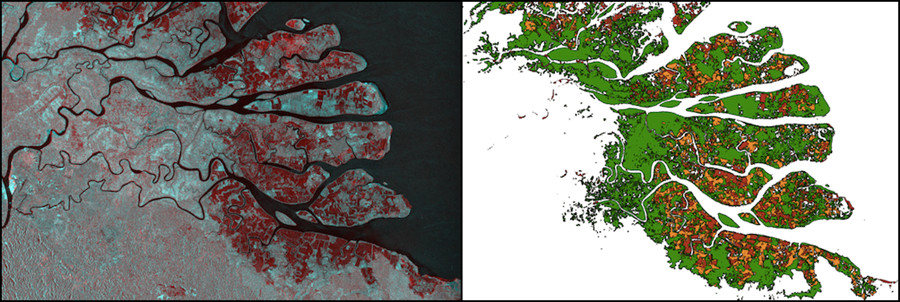Research & Meetings
The K&C Global Mangrove Watch
Background:
These changes can take place over decades but can also be very rapid, and updated information on their change status is therefore required on a regular basis. For countries reporting on the UN Sustainable Development Goals or participating in the REDD+ scheme, information about mangrove extents and changes over time is of critical importance.
While cloud cover limits the use of optical satellite data in tropical and sub-tropical regions, Synthetic Aperture Radar sensors are particularly well suited for mangrove monitoring as SAR data can be acquired regardless of clouds, smoke and haze. L-band SAR is particularly suitable as it is sensitive to both vegetation structure and to detect changes in time-series of data. With JAXA’s JERS-1 SAR, ALOS PALSAR and ALOS-2 PALSAR-2 missions a consistent L-band SAR data record spanning over two decades is available and provides a unique opportunity to map the extents and changes of the global mangrove cover the past 20 years.
Kahan river delta, North Kalimantan, Indonesia. (a–Left) Multi- temporal SAR composite (1996 JERS-1 SAR and 2016 ALOS-2 PALSAR-2) (b–Right) Mangrove extent and changes, Red – mangroves lost 1996-2007, Orange – loss 2007-2016, Green – mangrove cover in 2016.
Aims:
The Global Mangrove Watch (GMW) was initiated as part of the K&C Initiative in 2011. It is led by Aberystwyth University (U.K.) and solo Earth Observation (Japan), in collaboration with Wetlands International, the International Water Management Institute (Sri Lanka) and the UNEP World Conservation Monitoring Centre (U.K.). The GMW aims to provide geospatial information about mangrove extent and changes to the Ramsar Convention, national wetland practitioners, decision makers and NGOs. The primary objective of the GMW has been to provide countries lacking a national mangrove monitoring system with first cut mangrove extent and change maps, to help safeguard against further mangrove forest loss and degradation.
The GMW has generated a global baseline map of mangroves for 2010 using ALOS PALSAR and Landsat (optical) data, and changes from this baseline for seven epochs between 1996 and 2016 derived from JERS-1, ALOS and ALOS-2. Annual maps are planned from 2017 and onwards. The mangrove maps are publicly available through the World Resources Institute (WRI) Global Forest Watch portal (http://www.globalforestwatch.org) and for public (free of charge) download via the UNEP World Conservation Monitoring Centre, Ocean Data ViewerGMW Contact points
Dr. Ake Rosenqvist, GMW and K&C Science Coordinator
solo Earth Observation (soloEO)
Tokyo 104-0054, Japan
Email: aprojectjaxa.jp